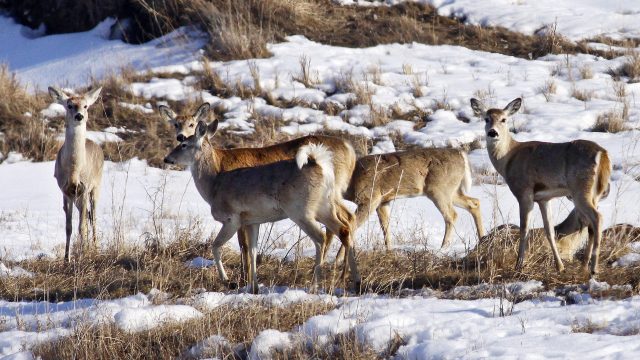Doug Leier Column: It's Time To Talk About Wildlife Survival Again

It’s that time of year again when lots of people start wondering about how North Dakota’s wildlife is surviving the winter.
Not that wild animals don’t have struggles the rest of the years, too. Finding enough to eat, or not getting eaten, are daily challenges year-round, but mix in a countryside covered in snow and cold temperatures, and popular species like deer and pheasants sometimes struggle to survive.
This winter obviously started out cold, but things have moderated a bit since early January. It’s too early to give the whole season a grade, but to this point it’s probably in the middle somewhere.
Many animals have adaptations that help them get through winter, but in some years even those natural defenses are not a sure hedge against death.
Some have thick winter coats, and their metabolism slows down. Bears hibernate. Sharp-tailed grouse have feathers out to their toes and other feathers that protect their nostrils from driven snow. Rabbits have large, fur-covered feet that help them move rapidly over deep snow.
Many bird species, of course, migrate south. A few mammals may migrate as well. Some pronghorn on occasion have moved from North Dakota into South Dakota, Wyoming or Montana in search of food that is not covered by snow. Elk in other more mountainous states will move from high elevations to wintering grounds in valleys.
The hard truth is, resident species that were unable to acclimate, or evolve with winters no longer occupy northern latitudes. It’s just the way nature works.
Humans can help the wildlife cause, too. Besides creating or preserving habitat, people can help animals conserve energy by simply keeping their distance during winter.
Many of us like to get out and enjoy what winter has to offer. We hike, ski, snowmobile, bird-watch and photograph and often we do this in or near wildlife habitat. The best thing we can do for any animals that might be around, is try to keep disturbance to a minimum.
For motorized machines like snowmobiles, staying on designated trails is important. Cutting through cattail marshes or undisturbed woods can frighten mammals and birds into the open. Not only do they needlessly have to burn energy, but they might be more accessible to predators.
Even cross-country skiers and hikers can interrupt an animal’s daily fight for survival. Most often these encounters are by coincidence and the skier or snowmobile or all-terrain-vehicle driver does his or her best to move on.
In a very few instances, however, the reaction is just the opposite and the snowmobiler for whatever reason takes off and pursues an animal.
Giving chase with a machine not only stresses the animal, but also gives the activity involved a bad name. The North Dakota Game and Fish Department encourages anyone witnessing such an action to report it as soon as possible to law enforcement or the Report All Poachers hotline at 800-472-2121.
Fox, coyotes, deer, pheasants, rabbits and all other wildlife that endures our winters should get special consideration during this time of year. We like to be out in the woods or riding along rivers or snow-shoeing across the prairie, and that can mean incidental meetings with wildlife.
That’s a big part of the reason we go outside. The key is to enjoy the moment, and then move on.




